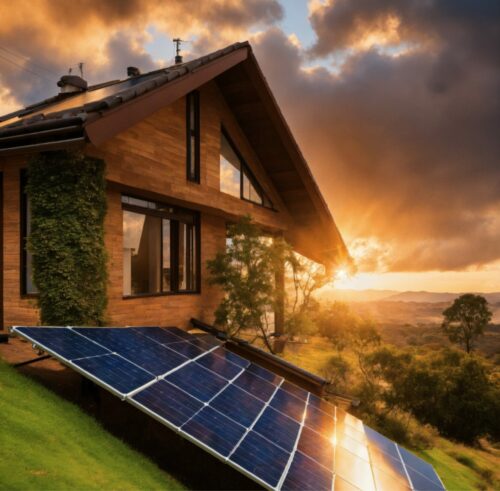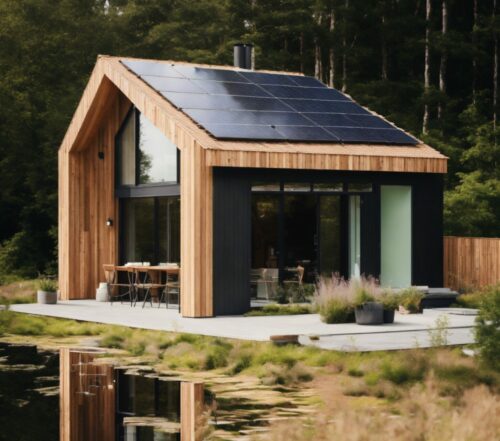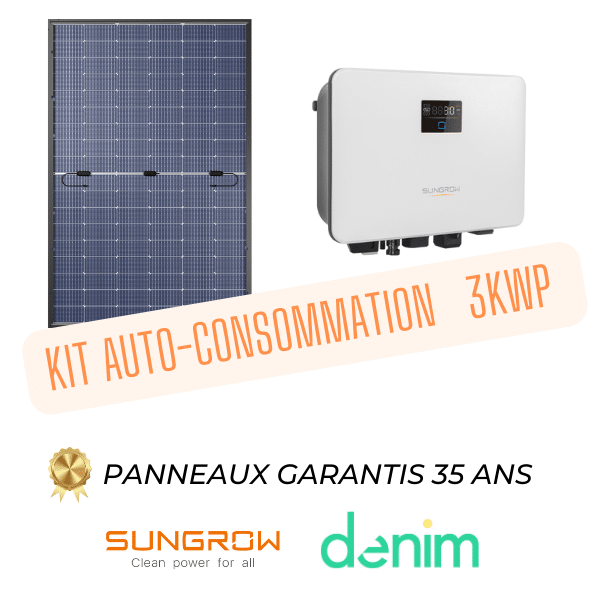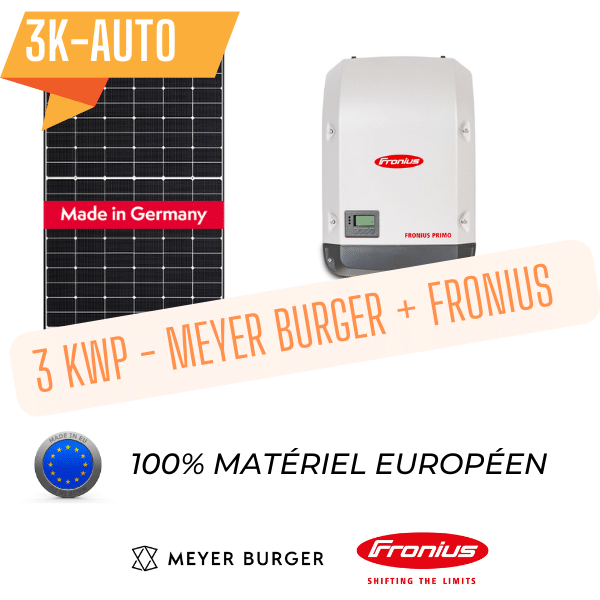Self-consumption Solar Kit: Optimize your energy with solar panels
Solar self-consumption, a true energy revolution, today transcends the status of a simple alternative to traditional energy sources to become a profound transformation of our methods of production and consumption of electricity. This practice, based on the use of the energy produced by your own photovoltaic solar panels to directly power your home, your business, or your agricultural installation, is part of a vision resolutely turned towards the future, energy autonomy and sustainability. Self-consumption kits, designed to facilitate this transition, integrate high-power solar panels and inverters capable of efficiently converting photovoltaic production into usable electricity.
These solar kits, intended to maximize your electricity production while guaranteeing optimal protection thanks to devices such as the surge protector and the disconnector, represent a strategic choice for those seeking to reduce their dependence on the traditional electricity network. The storage of excess energy, facilitated by solutions connected via Wi-Fi, allows intelligent management of your production, thus offering the possibility of maximizing the use of each kWh produced. In addition, the selection of a kit adapted to your needs, characterized by a solid guarantee and a competitive price, becomes crucial in the process of self-consumption.
The key to this transformation lies in the ability to choose products that meet not only power and storage capacity requirements but also protection and connectivity standards, as indicated by the presence of Wi-Fi interfaces for remote monitoring and management. The inverters, central elements of these kits, ensure optimal conversion of the electricity produced by the photovoltaic panels, while advanced features, such as a mobile application or a Wi-Fi key, allow precise monitoring of production in real time.

What is Photovoltaic Self-Consumption?
Photovoltaic self-consumption, the pivot of this energy revolution, exploits the inexhaustible potential of the sun to produce electricity. At the heart of this system, photovoltaic panels, key elements of any solar kit, capture sunlight and, thanks to the photovoltaic effect, convert it into electricity. This transformation is carried out using microinverters intended to optimize the power of each panel. Thus equipped, this installation allows immediate use of the green electricity generated, marking a decisive step towards energy autonomy from traditional and fluctuating energy networks.
The establishment of such a system includes not only the potential storage of excess energy, thanks to batteries specifically designed for photovoltaic installations, but also the protection of the whole by surge arresters, thus guaranteeing the safety and longevity of the installation. The solar kits, offering excellent value for money, are accompanied by solid guarantees, ensuring the reliability of your investment over the long term. This comprehensive approach, intended to maximize the efficiency and sustainability of your installation, represents a turnkey energy solution adapted to current and future needs in terms of renewable energy production.
Advantages of Self-Consumption with Solar Panels
The advantages of adopting a self-consumption solar system are multiple and significant. On the one hand, this provides substantial savings on electricity bills, as the energy produced is consumed directly, reducing dependence on energy purchased from traditional suppliers. On the other hand, it contributes to the reduction of greenhouse gas emissions, because solar energy is a clean, renewable and inexhaustible source of energy. By opting for self-consumption solar panels, you are making an informed choice for the environment, reducing your carbon footprint and actively participating in the fight against climate change.
Photovoltaic self-consumption also proves to be a flexible and scalable solution. Depending on the needs and investment possibilities, it is possible to start with a modest sized system, which can be expanded over time. This modularity ensures that solar self-consumption is accessible to a wide range of homes and businesses, providing a customizable solution that adapts to various energy consumption scenarios.
Understanding Solar Kits for Self-Consumption
Solar self-consumption is an eco-responsible approach that allows everyone to become a producer of green energy. At the heart of this approach, the solar kit for self-consumption offers a turnkey solution for those who wish to take this path. These kits are designed to simplify the process of installing and using solar panels, making self-consumption accessible to a wider audience.
The Components of a Self-Consumption Solar Kit
A solar self-consumption kit generally consists of several essential elements that work together to convert solar energy into electricity that can be used within the home or business. The main components include:
- Photovoltaic solar panels : The heart of the system, these panels capture solar energy and convert it into electricity. Photovoltaic technology has evolved considerably, today offering high yields even in low sunlight conditions.
- Inverter : This device converts the direct current generated by the panels into alternating current, compatible with the domestic electricity network and electrical appliances.
- mounting system : It secures the panels on the roof or on the ground. Its design must resist bad weather and optimize the orientation and inclination of the panels to maximize energy production.
- Storage batteries (optional) : They allow excess energy produced to be stored for later use, thus offering increased energy autonomy, especially during periods without sunlight.
- Wiring and electrical protections : Essential for connecting the different components together and guaranteeing the safety of the installation.
Choosing a solar kit adapted to your needs involves considering several parameters such as the surface area available for installing the panels, the sunshine in the region, and above all, the energy consumption of the home or business. The objective is to size the system so as to effectively cover this consumption, taking into account seasonal variations.
Choosing the Right Solar Panel Kit for your Project
Selecting the ideal solar self-consumption kit for your project requires an in-depth analysis of your current and future energy needs. Here are some criteria to consider:
- Energy consumption assessment : Determine your average consumption in kWh to identify the production capacity necessary for your installation. The power of solar panels, often expressed in watts (W) or kilowatts (kW), is directly linked to the production capacity necessary for your installation. By evaluating your average consumption in kWh, you can calculate the total power required for your solar panels in order to effectively cover this consumption, taking into account seasonal and daily variations in solar production.
- Available space : The surface area of your roof or land determines the number of panels you can install. The larger the space, the more flexibility you have to increase the capacity of your system.
- Type of panels : There are different types of solar panels, each with their advantages. Monocrystalline panels offer high efficiency but are generally more expensive. Polycrystalline panels, less expensive, can be an interesting alternative despite slightly lower efficiency.
- Storage batteries : If you are considering total self-consumption or want to maximize your energy independence, adding storage batteries may be wise. Evaluate your storage needs based on your nighttime consumption and periods of less intense sunlight.
- Performance and guarantees : Check the performance of the panels and the guarantees offered by the manufacturer. A high quality panel with an extended warranty is an investment in the sustainability of your project. Warranties, which can cover both the long-term performance of the panels and any manufacturing defects, are essential to secure your investment. A high-quality solar panel, backed by an extended warranty, assures you that your installation will continue to produce electricity at an optimal level for many years, and protects you against possible failures or significant reductions in performance.
Professional support can be invaluable in navigating the complexity of available options and selecting the solar kit that best meets your specific needs. A well-planned and sized installation is the key to optimizing your solar energy production and maximizing your long-term savings.
Installation of Your Self-Consumption Solar System
Key stages of photovoltaic installation
Installing a photovoltaic system requires careful planning and execution to ensure both safety and optimal system efficiency. Here are the key steps to follow:
- Preliminary assessment and system design : First of all, it is essential to carry out an assessment of your site (orientation, sunlight, shadows) and to determine your energy needs. This step allows you to design a tailor-made system that will best meet your expectations.
- Obtaining the necessary authorizations : Depending on your location, administrative procedures with local authorities or your energy supplier (such as Enedis in France) may be necessary before starting the installation.
- Installing the mounting brackets : Whether on a roof or on the ground, the mounting system must be securely attached to support the weight of the panels and resist bad weather.
- Installation of solar panels : The panels are fixed on the prepared supports. Their orientation and inclination are crucial to optimize energy production.
- Installing the inverter and electrical system : The inverter, which converts direct current into alternating current, is installed and connected to the panels and the electrical network of the house.
- Network connection and commissioning : After checking that all components are functioning correctly, the system can be connected to the electrical network. Inspection by a professional may be required to validate commissioning.
Plug and play solar: Simplified solution for beginners
For those looking for a less complex solution, the plug and play solar panel system represents an attractive option. These systems are designed to be easily installed without the intervention of specialists, providing a simplified route to solar self-consumption. With pre-assembled kits and clear instructions, they allow for quick installation, often in just a few hours. However, although simplified, this option may have limitations in terms of customization and scalability compared to traditional systems.
The importance of the battery in total self-consumption
Integrating a battery into your solar self-consumption system, an essential component of any solar kit, plays a crucial role in increasing your energy independence. Intended to store excess energy produced during sunny hours, the battery ensures the supply of electricity during periods of lower solar production, such as at night or cloudy days. This storage device, often accompanied by a surge protector to protect the installation against surges, is specially designed for photovoltaic installations wishing to maximize their self-consumption rate while reducing their dependence on the traditional electricity network.
Choosing the right storage capacity, in line with the power of the kit's panels and consumption needs, is crucial to optimize battery use and guarantee the profitability of your investment. Modern solar kits incorporate microinverters that improve the energy conversion of each panel, thereby optimizing the production of energy to be stored. By considering the price and the guarantee offered, it is possible to invest in a solar self-consumption solution adapted to your specific needs, ensuring efficient management of the energy produced and stored for increased energy autonomy.
Manage surplus energy from your photovoltaic panels
Following the installation of your solar system dedicated to self-consumption, it is very possible that the quantity of energy generated exceeds your daily needs. This surplus of solar electricity opens the door to important strategic decisions, in particular the option of self-consumption with sale of the surplus. You are therefore faced with a choice: keep the excess energy for your future needs or opt for its sale in order to benefit from additional income.
Storage vs. sale of surplus: What options?
Energy storage : Using batteries to store excess energy is an effective solution to maximize your energy independence. This allows you to use stored solar energy during periods of low solar production or at night, reducing your reliance on the power grid. Storage has the advantage of securing your energy supply, particularly during network outages or price increases. However, the initial investment in a storage system can be significant, and it is important to calculate the return on investment based on your energy needs and installation costs.
Sale of surplus energy : Selling your surplus energy to the grid is another attractive option, not only reducing your electricity bill but also generating income. In many countries, remuneration mechanisms, such as the guaranteed feed-in tariff, encourage renewable energy producers to sell their surplus. This option requires a grid connection and a contract with an energy supplier or network operator, who will purchase excess energy at a set price.
Partner with Enedis for the sale of surplus
In France, for self-consumption solar installations, partnering with Enedis (the electricity distribution network manager) is a common approach for selling surplus energy. Enedis offers purchase contracts for surplus energy produced, allowing solar energy producers to benefit from additional income while contributing to increasing the share of renewable energy in the national energy mix.
For this, it is necessary to:
- Install a production meter : This meter, distinct from the consumption meter, measures the quantity of electricity injected into the network.
- Sign a contract for the sale of the surplus : After having taken the necessary steps with Enedis, a contract specifying the terms of sale and the purchase price for your surplus energy will be established.
- Respect standards and regulations : It is crucial to ensure that your installation complies with all the standards in force for the safety and quality of the energy injected into the network.

Optimizing your solar self-consumption system
To maximize the benefits of your solar self-consumption system, particular attention must be paid not only to the design and installation but also to the continuous optimization of its operation. This involves regular monitoring and adequate maintenance of the solar panels, thus ensuring optimal energy production in the long term.
Monitoring and maintenance of solar panels
Performance monitoring : The efficiency of a solar installation can vary depending on many factors, such as weather conditions, accumulation of dust or debris, and aging of components. Regular monitoring, facilitated by intelligent energy management systems, allows energy production to be monitored in real time and any problems or declines in performance to be quickly identified. Many solutions include mobile apps that provide detailed data on energy production and consumption, making your system easier to manage.
Preventive and corrective maintenance : To ensure consistent and reliable solar power generation, regular maintenance of solar panels is crucial. Preventative maintenance includes cleaning the panels to remove dust, leaves, or anything else that may block sunlight. It may also include periodic checks of electrical connections, structural integrity of mounting brackets, and proper operation of the inverter.
In the event of a failure detected during monitoring, corrective maintenance must be carried out. This may involve replacing damaged or faulty components, such as the inverter or some solar panels. The intervention of a qualified professional is recommended for any corrective maintenance to ensure safety and effective restoration of system performance.
Optimization based on data tracking : The data collected by monitoring your installation can also be used to optimize its operation. For example, if monitoring reveals that production is consistently higher than consumption during certain times of the year, you might consider adding battery storage to capture the excess energy. Alternatively, this data can indicate the optimal time to sell excess energy to the grid, maximizing your revenue.
Conclusion: Towards Sustainable Solar Self-Consumption
The adoption of solar self-consumption through solar kits represents a significant evolution towards more sustainable and economical energy consumption. Directly using the energy generated by solar panels propels you towards energy independence, while actively contributing to the protection of the environment thanks to a notable reduction in your carbon footprint.
The selection and optimization of a suitable solar system requires consideration of your energy needs, available space, and the potential for integrating storage batteries, thus ensuring effective management of surplus energy, whether by storage or by sale.
As a professional in the sector, Perma Batteries brings its expertise and tailor-made support to guide you at each stage of your solar self-consumption project, guaranteeing a solution perfectly adapted to your specific needs and thus helping to optimize your transition towards cleaner and more autonomous energy.
I CONTACT PERMA BATTERIES FOR A QUOTE REQUEST.
-
Sungrow 3kWp self-consumption kit
1.750,00€ - 2.000,00€ -
Fronius 3kWp self-consumption solar kit
3.999,00€


